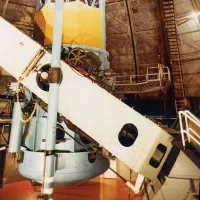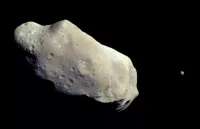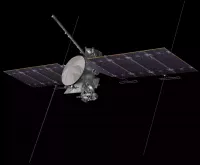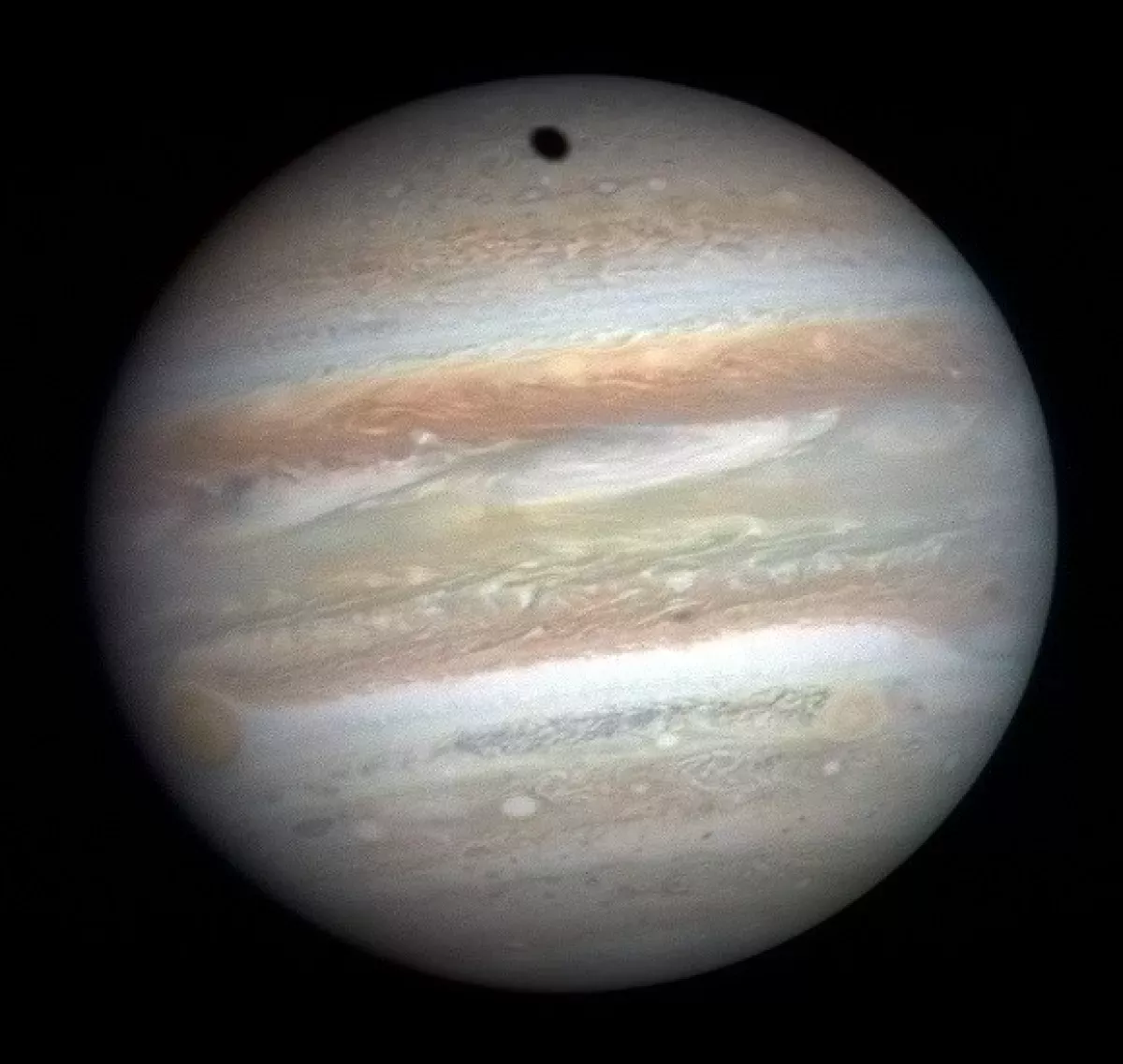Jupiter is the fifth and largest planet from the Sun, a gas giant exceeding the mass of all other Solar System planets combined. It orbits the Sun at 5.20 AU with an 11.86-year period. Its diameter is 11 times that of Earth. After the Moon and Venus, it's the third-brightest object in Earth's night sky, observed since prehistoric times. The planet is named after the chief Roman deity, Jupiter.
1906: Discovery of Achilles
In 1906, 588 Achilles, the first trojan asteroid of Jupiter, was discovered by Max Wolf.
1932: Identification of Ammonia and Methane
In 1932, Rupert Wildt identified absorption bands of ammonia and methane in the spectra of Jupiter.
1938: Observation of White Ovals
In 1938, three long-lived anticyclonic features called "white ovals" were observed on Jupiter.
1939: Formation of White Oval Storms
In 1939, smaller, white oval-shaped storms were formed on Jupiter, which would eventually merge to create Oval BA.
1940: Formation of White Oval Storms
In 1940, smaller, white oval-shaped storms were formed on Jupiter, which would eventually merge to create Oval BA.
1955: Discovery of Jupiter's Radio Waves
In 1955, Bernard Burke and Kenneth Franklin discovered that Jupiter emits bursts of radio waves at a frequency of 22.2 MHz.
1973: Pioneer Missions' Discoveries
Beginning in 1973, several spacecraft performed planetary flyby maneuvers that brought them within the observation range of Jupiter. The Pioneer missions obtained the first close-up images of Jupiter's atmosphere and several of its moons. They discovered that the radiation fields near the planet were much stronger than expected.
1973: First Robotic Probe Visits
In 1973, the first robotic probe visited Jupiter. Since then, Jupiter has been visited by nine robotic probes: seven flybys and two dedicated orbiters, with two more en route.
1973: First Automated Spacecraft Visit
Since 1973, Jupiter has been visited by automated spacecraft, when the space probe Pioneer 10 passed close enough to Jupiter to send back revelations about its properties and phenomena.
1976: Formal Adoption of the Name Jupiter
In 1976, the International Astronomical Union formally adopted the name Jupiter for the planet and has since named its newly discovered satellites for the god's lovers, favorites, and descendants.
1979: Voyager 1 Flyby
Before the flyby of the Voyager 1 probe in 1979, eight additional satellites of Jupiter were discovered.
February 1992: Ulysses Solar Probe Flyby
In February 1992, the Ulysses solar probe performed a flyby maneuver of Jupiter to attain a polar orbit around the Sun. During this pass, the spacecraft studied Jupiter's magnetosphere.
July 1994: Comet Shoemaker–Levy 9 Impact
In July 1994, the Comet Shoemaker–Levy 9 comet collided with Jupiter. The impacts were closely observed by observatories around the world, including the Hubble Space Telescope and Galileo spacecraft.
1994: Comet Shoemaker-Levy 9 Impact
In 1994, the Galileo spacecraft witnessed the impact of Comet Shoemaker–Levy 9 when it collided with Jupiter.
July 1995: Galileo Probe Enters Jupiter's Atmosphere
In July 1995, a 340-kilogram titanium atmospheric probe was released from the Galileo spacecraft, entering Jupiter's atmosphere on December 7.
December 7, 1995: Galileo Mission Arrival
On December 7, 1995, the Galileo mission reached Jupiter and became the first spacecraft to orbit the planet. It remained in orbit for over seven years, conducting multiple flybys of all the Galilean moons and Amalthea.
1997: Review of Impact Observations
A 1997 review determined that early astronomical records and drawings from 1664 to 1839 had little or no possibility of documenting actual impacts on Jupiter.
1998: Merging of White Ovals
In 1998, two of the white ovals on Jupiter merged together.
1999: Discovery of Outer Moons Complicates Classification
The discovery of numerous small outer moons since 1999 complicated the prior classification of Jupiter's moons into four groups of four, based on their similar orbital elements.
2000: Formation of Oval BA
In 2000, an atmospheric feature formed in the southern hemisphere that is similar in appearance to the Great Red Spot, but smaller. The merged feature was named Oval BA.
2000: Cassini Probe Flyby
In 2000, the Cassini probe flew by Jupiter on its way to Saturn, and provided higher-resolution images.
2000: White Ovals Absorb Third Oval
In 2000, the merged white ovals on Jupiter absorbed the third oval, becoming Oval BA.
September 21, 2003: Galileo Orbiter Destroyed
On September 21, 2003, the Galileo orbiter was deliberately steered into Jupiter to be destroyed, preventing contamination of the moon Europa.
2005: Cancellation of JIMO
Due to funding difficulties, NASA's JIMO (Jupiter Icy Moons Orbiter) mission was cancelled in 2005.
2007: New Horizons Probe Flyby
In 2007, the New Horizons probe flew by Jupiter for a gravity assist en route to Pluto. The probe's cameras measured plasma output from volcanoes on Io and studied all four Galilean moons in detail.
2008: Computer Simulations of Cometary Bombardment
Computer simulations in 2008 suggest that Jupiter does not cause a net decrease in the number of comets that pass through the inner Solar System, as its gravity perturbs their orbits inward roughly as often as it accretes or ejects them.
April 2011: ESA Ends Partnership on EJSM/Laplace
In April 2011, the ESA formally ended the partnership with NASA on the EJSM/Laplace mission, citing budget issues at NASA.
2015: Great Red Spot Size Measurement
As of 2015, the Great Red Spot was measured at approximately 16,500 by 10,940 kilometers and decreasing in length by about 930 km per year.
July 4, 2016: Juno Mission Arrival
NASA's Juno mission arrived at Jupiter on July 4, 2016, with the goal of studying the planet in detail from a polar orbit.
August 27, 2016: Juno's First Flyby
On August 27, 2016, the Juno spacecraft completed its first flyby of Jupiter and sent back the first-ever images of Jupiter's north pole.
2016: Babylonians Used Trapezoidal Rule
A 2016 paper reports that the trapezoidal rule was used by Babylonians before 50 BC for integrating the velocity of Jupiter along the ecliptic.
April 2017: Discovery of Great Cold Spot
In April 2017, a "Great Cold Spot" was discovered in Jupiter's thermosphere at its north pole.
July 2018: End of Juno's Budgeted Mission
Juno completed 12 orbits before the end of its budgeted mission plan, ending in July 2018.
2020: Provisional Launch Date of EJSM/Laplace
A subsequent proposal was developed for a joint NASA/ESA mission called EJSM/Laplace, with a provisional launch date around 2020.
July 2021: Extension of Juno Mission
In June of 2018, NASA extended the Juno mission operations plan to July 2021.
October 2021: Juno Flyby Measures Great Red Spot Depth
In October 2021, a Juno flyby mission measured the depth of the Great Red Spot, putting it at around 300–500 kilometers.
April 14, 2023: Launch of JUICE
The European Space Agency's Jupiter Icy Moon Explorer (JUICE) mission was launched on April 14, 2023.
October 14, 2024: Launch of Europa Clipper
NASA's Europa Clipper mission was launched on October 14, 2024.
September 2025: Planned End of Extended Juno Mission
In January of 2021, the Juno mission was extended to September 2025 with four lunar flybys: one of Ganymede, one of Europa, and two of Io.
2035: Planned Launch of Tianwen-4
The Chinese National Space Administration's Tianwen-4 mission, which aims to launch an orbiter to the Jovian system and possibly Callisto, is planned for around 2035.
Mentioned in this timeline
NASA the National Aeronautics and Space Administration is an independent...

A telescope is an instrument used to observe distant objects...

Asteroids are minor planets orbiting the inner Solar System or...

The wolf or grey wolf is a canine native to...

September is the ninth month of the year in the...

The Europa Clipper launched by NASA on October is on...
Trending
14 days ago Colts release kicker Michael Badgley after tryouts, seek new options for the team.

1 month ago Alex Bregman Enters Free Agency; Red Sox Interested, Projected $160M Deal?

2 months ago Shaq Appreciates Allen Iverson's Tearful Expression of Friendship, Calling Him 'Real'

8 months ago Purdy contract talks progress positively; Kittle denies contract dispute rumors, focusing on team.

8 months ago David Spade's SNL sickness nearly forced NBC to air a rerun; Larry David meets McCartney.
Caleb Ferguson is an American professional baseball pitcher currently playing for the Pittsburgh Pirates in MLB Before joining the Pirates...
Popular

Candace Owens is an American conservative political commentator and author...

Ilhan Omar is an American politician currently serving as the...

XXXTentacion born Jahseh Dwayne Ricardo Onfroy was a controversial yet...

Oprah Winfrey an American talk show host television producer actress...

Frederick Christ Trump Sr - was an American real estate...

Bill Gates an American businessman and philanthropist revolutionized personal computing...
